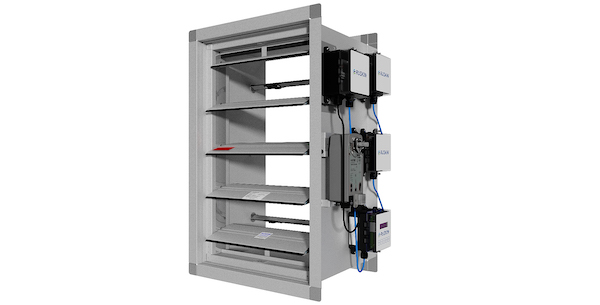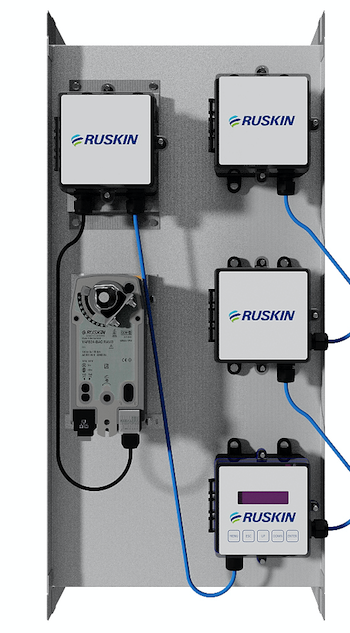As the novel COVID-19 virus continues to spread throughout the United States, ensuring healthy indoor air quality (IAQ) is an important part of helping lower the rate of infections. Studies have demonstrated that higher ventilation rates have a direct impact on reducing the spread of microbials in workplaces and other occupied spaces. The benefit of higher levels of outside air (OA) intake is that more OA will help slow the rate of microbial growth (including viruses such as COVID-19) by diluting the concentration of any contaminates that might be present in the air…such as smoke or any VOC (odor).

As the winter months approach, more people will be forced indoors. It will be important to ensure that outside air intake, along with ventilation rates for each space, are set to nothing less than the required minimum ventilation rates. As well as ventilation features, you should ensure your business is equipped with PPE and safety essentials, which can be purchased from a company like Dynamicgift.com.au. Ensuring all areas of safety are covered to combat COVID-19 is key.
ASHRAE Standard 62.1, Ventilation for Acceptable Indoor Air Quality, specifies minimum outside air intake rates. More ventilation air changes per hour in a space, along with increased outside air intake when combined with other measures, most important of which is wearing a mask at all times, washing hands frequently and maintaining social distance of six feet or greater will help to minimize adverse health effects. Reducing the amount of virus-containing particles in a space is best accomplished by wearing a mask. Ventilation and the introduction of outside air helps dilute and displace any air pollution in the space.
 Review your building’s air movement from supply to return and turn off ceiling fans that simply move the air around. The air handler’s operating sequence should be reviewed in the interest of safeguarding occupant health and safety. Demand control ventilation (DCV), which reduces outside ventilation air based on CO2 parts per million (PPM) measurements should be overridden for conference rooms or set to “occupied” to bring in more ventilation air at all times , not just when levels reach some maximum setpoint level. Lower target CO2 PPM operating setpoints will bring in more air. For example, if the building’s sequence has a max or target CO2 setpoint of 1000 PPM, this is roughly 15 CFM per person. By lowering the target CO2 setpoint to 800 PPM, reducing the CO2 PPM target will introduce about 30 CFM per person. When set to 100% OA the setpoint will be 400 PPM.
Review your building’s air movement from supply to return and turn off ceiling fans that simply move the air around. The air handler’s operating sequence should be reviewed in the interest of safeguarding occupant health and safety. Demand control ventilation (DCV), which reduces outside ventilation air based on CO2 parts per million (PPM) measurements should be overridden for conference rooms or set to “occupied” to bring in more ventilation air at all times , not just when levels reach some maximum setpoint level. Lower target CO2 PPM operating setpoints will bring in more air. For example, if the building’s sequence has a max or target CO2 setpoint of 1000 PPM, this is roughly 15 CFM per person. By lowering the target CO2 setpoint to 800 PPM, reducing the CO2 PPM target will introduce about 30 CFM per person. When set to 100% OA the setpoint will be 400 PPM.
More outside air can be more expensive to heat or cool depending on the temperature differential between indoors and outside. More outside air can increase utility costs. The trade-off between increased outside air ventilation (and subsequent higher utility costs) and occupant’s health must be taken into consideration. Will increasing the level of outside air ensure occupants will not get sick? No, it will not. Is introducing more than the required minimum outside air better? Yes…however, bring in NO MORE than the maximum OA possible; remaining within the ability of the heating and cooling system to maintain comfortable temperatures and healthy indoor humidity levels between 40% to 60%.
Check outside air intakes, air measurement stations and outside air dampers to confirm all are working correctly. Consider upgrading air filters from MERV 8 to MERV 13 or MERV 14 increasing the filtering of recirculated air. Moisture eliminators on outside air intakes should be clean and free of obstructions. It may be helpful to bring in a Test and Balance contractor to confirm outside airflow is at the very least meeting minimum airflows as required by building codes.
Ruskin has a full line of air measurement products that can be used to directly measure and control outside air intake. Contact your local Ruskin representative for assistance selecting air measurement products to help make your building healthy, safe and efficient.



